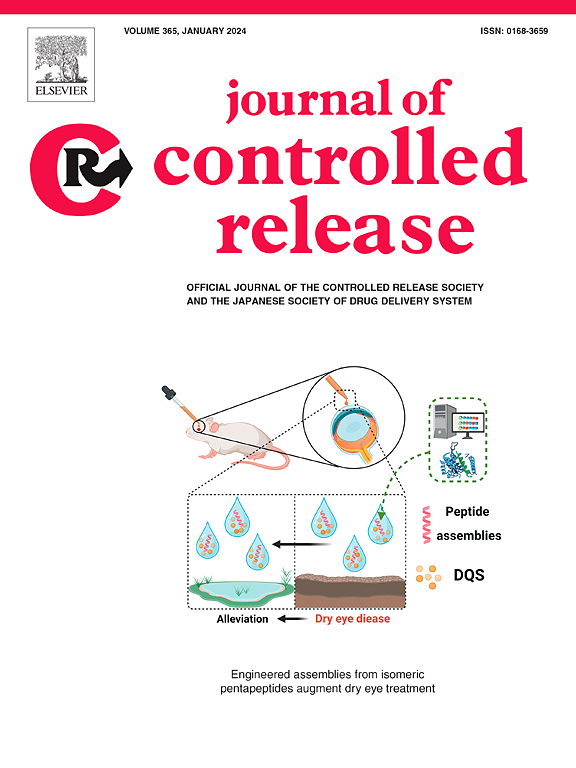Functional lipid nanoparticles for safe delivery of macromolecular antibiotics to gram-negative bacteria
IF 10.5
1区 医学
Q1 CHEMISTRY, MULTIDISCIPLINARY
引用次数: 0
Abstract
Lipid nanoparticles (LNPs) hold great potential for delivery of macromolecular antimicrobials. Herein, we designed a series of anionic LNPs capable of delivering cationic polymyxin B (PMB) for effective and safe treatment of Gram-negative bacterial infection. The use of anionic lipid induced self-assembly of PMB, encapsulating cationic PMB molecules into LNPs via electrostatic interactions (PMB-LNPs). Anionic lipid architecture and lipid:PMB mixing ratios had a substantial influence on particle size, surface charge, and drug release properties of PMB-LNPs. Following in vitro screening assays, C14-Glu5/PMB (1:4) LNP was identified as the lead formulation due to its potent bactericidal activity against a panel of tested Gram-negative bacteria strains. Confocal and SEM imaging studies validated the importance of fractionated PMB release in mediating the enhanced binding of C14-Glu5/PMB (1:4) LNPs on the bacterial outer membrane. Additionally, PMB-LNPs conferred prolonged blood circulation, preferential liver accumulation, and superior tolerability over free PMB. In a murine neutropenic A. baumannii infection model, administration of C14-Glu5/PMB LNPs eliminated bacteria in the liver and suppressed bacterial regrowth in the kidney more effectively than free PMB, resulting in an improved body weight status and histological appearance. This study may provide insights into the de novo design of LNP-based nanomedicines for antimicrobial therapies.

功能性脂质纳米颗粒用于安全递送大分子抗生素给革兰氏阴性菌
脂质纳米颗粒(LNPs)具有递送大分子抗菌剂的巨大潜力。在此,我们设计了一系列能够递送阳离子多粘菌素B (PMB)的阴离子LNPs,用于有效和安全的治疗革兰氏阴性细菌感染。阴离子脂质诱导PMB自组装,通过静电相互作用将阳离子PMB分子封装到LNPs中(PMB-LNPs)。阴离子脂质结构和脂质与PMB的混合比例对PMB- lnps的粒径、表面电荷和药物释放性能有实质性影响。经过体外筛选试验,C14-Glu5/PMB (1:4) LNP被确定为领先配方,因为它对一组测试的革兰氏阴性细菌菌株具有有效的杀菌活性。共聚焦和扫描电镜成像研究证实了PMB的分离释放在介导C14-Glu5/PMB (1:4) LNPs在细菌外膜上的增强结合中的重要性。此外,与游离PMB相比,PMB- lnps具有延长血液循环,优先肝脏积累和更好的耐受性。在小鼠中性粒细胞减少鲍曼不对称杆菌感染模型中,与游离PMB相比,给予C14-Glu5/PMB LNPs更有效地消除了肝脏中的细菌,抑制了肾脏中的细菌再生,从而改善了体重状况和组织学外观。该研究可能为基于lnp的抗菌治疗纳米药物的从头设计提供见解。
本文章由计算机程序翻译,如有差异,请以英文原文为准。
求助全文
约1分钟内获得全文
求助全文
来源期刊

Journal of Controlled Release
医学-化学综合
CiteScore
18.50
自引率
5.60%
发文量
700
审稿时长
39 days
期刊介绍:
The Journal of Controlled Release (JCR) proudly serves as the Official Journal of the Controlled Release Society and the Japan Society of Drug Delivery System.
Dedicated to the broad field of delivery science and technology, JCR publishes high-quality research articles covering drug delivery systems and all facets of formulations. This includes the physicochemical and biological properties of drugs, design and characterization of dosage forms, release mechanisms, in vivo testing, and formulation research and development across pharmaceutical, diagnostic, agricultural, environmental, cosmetic, and food industries.
Priority is given to manuscripts that contribute to the fundamental understanding of principles or demonstrate the advantages of novel technologies in terms of safety and efficacy over current clinical standards. JCR strives to be a leading platform for advancements in delivery science and technology.
 求助内容:
求助内容: 应助结果提醒方式:
应助结果提醒方式:


